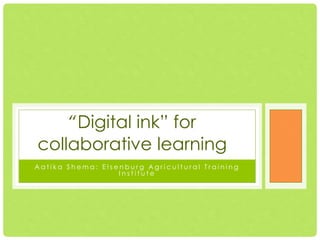
Digital ink for collaborative learning
- 1. “Digital ink” for collaborative learning Aatika Shema: Elsenburg Agricultural Training Institute
- 2. CURRICULUM FOCUS • A Soil Science 1 course • Soil and water as a natural resource in the agricultural sector • Do calculations to determine the status of the soil or water to make a decision within an agricultural context. • The students are taught the skill of problem solving that is used in this module as well as the subjects to which it articulate.
- 3. STUDENT NEEDS • Integrate conceptual and mathematical aspects to solve problems (Heller et.al., 1992) • Diverse backgrounds and varying academic abilities. • Lecturing material and class notes available off- campus • Understand the problem solving steps within an agricultural setup.
- 4. RATIONALE • The change in student profile • Investigate into teaching strategies that engage the student in class and promote active learning. • In the traditional class setup • Calculations and problem solving difficult with the normal Powerpoint and large classes to achieve this (Theys et. al., 2005). • The tablet enhances collaboration and communication, students learn from each other (Crouch and Mazur, 2001) • Actual class notes available (Theys et. al., 2005).
- 5. CONTEXT WHERE IT TOOK PLACE • The tablet in the classroom for • In the formal class setup formal lecture mechanical rhythm disrupted. • It will replace the laptop or • Switch between different computer (Heller et. al., 1992) presentation modes • In a tutorial session 3 or 4 • Instructional language is a students with a tablet that can barrier connect to a central projector • Peer instruction and (Theys et. al., 2005) collaborative learning eliminate • The focus is the problem this blockage and it solving skills with associated encourages self-explanations decision making through (Mason, 2001; Brüssow & collaborative learning and peer Wilkinson, 2010). In order to instruction explain it to others they need to have the reasoning behind every step.
- 6. OUTCOMES AND INTENTIONS • Keep students interested - not a major but compulsory to pass • Solve problems in real time and make decisions through a process of critical thinking (Brüssow & Wilkinson, 2010). • Bridging the language barrier • Promotes higher level thinking and reasoning (Mason, 2001). • Students take responsibility for their own learning (Van der Meer & Scott, 2008).
- 7. TECHNOLOGY ENHANCED ACTIVITY • Live presentations and problem-and-answers are published in LMS (Winer & Cooperstock, 2002) • Remote access and post their questions from a web- enabled cell phone • In tutorial - collaborative learning and peer instruction (Van der Meer & Scott, 2008; Mason, 2001; Crouch & Mazur, 2001). • Groups with a tablet that can connect to a central projector. • Groups selected by the lecturer • Each group must solve a problem to make a real time decision and explain to the tutorial class the steps and reasoning to reach the decision.
- 8. STUDENT FEEDBACK • In the class setup - very interesting and helpful for the problem solving through a step-by-step process • Files that are available with audio even on a cell phone very useful for preparation • Tablet has positive effect on their learning with active participation in the tutorial that made them feel • important, • comfortable and • part of the team and • in the end they know exactly where they stand • Compile groups strategically and facilitate the sessions • Sometimes the explanations in the tutorials were too fast
- 9. ASSESSMENT • Formative evaluation in the tutorial session • students are graded on • ability to scrutinise the information • logical reasoning • apply the correct mathematical equations • reach an answer • make a decision • explain the whole process (Crouch & Mazur, 2001). • Each student in the group has a different role and this is shifted in each tutorial. • In the summative evaluation - similar real time problems that must be solved. • Graded on • identifying what is required, • applying the concepts and mathematical equations, • calculating an answer and • making a decision.
- 10. • An increase in class attendance keep students interested • Posing questions • In summative assessment – solve real time problems solve problems • Achieved with collaborative learning Bridging the language • In summative assessment – not barrier reached • Not properly assessed promotes higher level • Real time problem solving not clear thinking reflection
- 11. REFERENCE • Brüssow, S.M. & Wilkinson, A.C. (2010). Engaged learning: A pathway to better teaching, 24(3), 374-389. • Crouch, C.H. & Mazur, E. (2001) Peer Instruction: ten years of experience and results. American Journal of Physics, 69(9), 970-977. • Dabbagh, N. & Bannan-Ritland, B. (2005). Chapter 6: Instructional strategies that support constructivist-based pedagogical models. In: Online learning: Concepts, strategies and application. Upper Saddle River, New Jersey: Pearson, 206-227. • Heller, P., Keith, R. and Anderson, S. (1992). Teaching problem solving through cooperative grouping. Part 1: Group versus individual problem solving, American Journal of Physics, 60(7), 627-636. • Mason, L. (2001). Introducing talk and writing for conceptual change: a classroom study, Learning and Instruction, 11, 305-329. • Theys, M.D., Lawless, K. and George, S. (2005). Tablet computers and the traditional lecture. In: 35th ASEE/IEEE Frontiers in Education Conference, 19- 22. Indianapolis. • Van der Meer, J. & Scott, C. (2008). Shifting the balance in first year learning support: from staff instruction to peer learning primacy, 1(1), 70-79. • Winer, L.R. & Cooperstock, J. (2002). The “intelligent classroom”: changing teaching and learning with an evolving technological environment, Computers & Education, 38, 253-266.